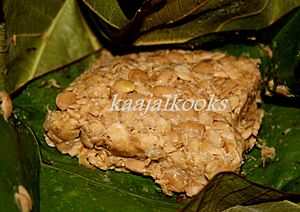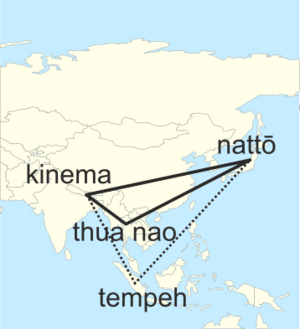Kinema facts for kids

Kinema on a traditional leaf wrapping
|
|
| Alternative names | Chembihik, hokuma |
|---|---|
| Type | Fermented food |
| Place of origin | Limbuwan (present day Eastern Nepal) and Sikkim, India |
| Region or state | Nepal, India (Sikkim, Darjeeling, Kalimpong), Bhutan |
| Created by | Limbu people |
| Main ingredients | Soybean fermented by Lactobacillus |
Kinema (Nepali: किनेमा) is a special food made from soybeans. It's popular in the Eastern Himalayas region. This includes places like Eastern Nepal and parts of India, such as Darjeeling, Kalimpong, and Sikkim.
Kinema is a traditional food for the Limbu people. It's also enjoyed by other Kirati communities in the area. What makes Kinema unique is that it's a fermented food. This means tiny living things, like good bacteria, help change the soybeans.
Contents
What is Kinema?
Kinema is made by letting soybeans ferment. This process changes the beans and gives them a special taste and smell. It's a bit like how yogurt is made from milk, but with soybeans!
Where Does the Name Come From?
The name Kinema comes from the Limbu language. The Limbu word kinambaa means "fermented flavor." So, the name tells you exactly what it is! People in other areas sometimes call it chembihik or hokuma.
How Old is Kinema?
Experts believe Kinema is a very old food. A microbiologist named Jyoti Prakash Tamang thinks it started a long, long time ago. It might have been first made by the Limbu people between 600 BC and 100 AD. That's over 2000 years ago!
How People Eat Kinema
Kinema has a unique texture and smell because of the fermentation. It's often made into a soup. This soup is usually eaten with rice.
But Kinema is also very versatile! You can turn it into a tasty dip. Or it can be a strong-flavored side dish. People enjoy it with rice or even bread.
Most families traditionally make Kinema at home. But now, you can find it in local markets. You can even buy dried Kinema online!
Why Kinema is Healthy
| Nutritional value per 100 g (3.5 oz) | |
|---|---|
| Energy | 2,000 kJ (480 kcal) |
|
28g
|
|
|
17g
|
|
|
Protein
|
48g
|
| †Percentages estimated using US recommendations for adults. | |
Kinema is considered a very healthy food. The fermentation process helps break down complex proteins in the soybeans. This makes them easier for your body to digest. It's like your food is partly "pre-digested" for you!
Kinema is also more alkaline than regular soybeans. This means it's less acidic. For every 100 grams of dry Kinema, you get a lot of good stuff:
- About 48 grams of protein
- Around 28 grams of carbohydrates
- About 17 grams of fat
It also provides a good amount of energy for your body.
Other Fermented Soybean Foods
Kinema is not the only fermented soybean food out there! Many other countries in Asia have their own versions. They are all made by fermenting soybeans, but they taste and look different.
Some examples include:
- shuǐdòuchǐ from China
- cheonggukjang from Korea
- tempeh from Indonesia
- nattō from Japan
- thua nao from Thailand
There are also many similar foods in different parts of India. These include tungrymbai, hawaijaar, bekangum, akhuni, and piak.
The "Natto Triangle"
A Japanese expert named Sasuke Nakao came up with an idea called the "natto triangle." This triangle connects Kinema, Natto (from Japan), and Thua Nao (from Thailand). It shows how these similar fermented soybean foods are related across Asia.
Later, Jyoti Prakash Tamang (the microbiologist) made an even bigger triangle. He called it the "KNT (Kinema-Natto-Thua Nao) triangle." This triangle helps us see how these special foods are connected across the whole continent of Asia.


